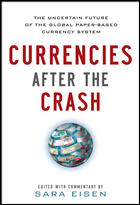 |
This book is a series of nine essays about the state of currency in our global economy after the 2008-2009 economic crisis. The contributor list is impressive: global currency luminaries such as Anoop Singh of the IMF, Robert Johnson of the Global Finance Project, Jörg Asmussen of the European Central Bank, and many others of similar pedigree. The book is edited by Sara Eisen of Bloomberg.
This book doesn’t lend itself well to description, other than that each of the contributors provides a snippet of insight into the global currency situation as it stands today, from his or her professional perspective.
Most of the essays point out that the US dollar is not in the crisis situation that the popular press would have us believe. Yes, the dominance of the dollar has diminished in recent years, but a replacement as dominant currency worldwide is not eminent from either the euro or the yuan, the only two contenders at this point.
That’s not to say that the dollar doesn’t have it’s problems – it’s just that the dominance of the dollar is so huge that it can’t be replaced in the very near term. And during that period the US has the opportunity to right the ship and possibly maintain the dominance of the dollar.
The euro and the European Central Bank have a slew of problems that must be addressed in order to maintain viability as an economy – including the likely paring down of the membership to eliminate some of the problem child nations such as Greece. This will likely keep the euro as a minor player on the world stage, still a major component of the western European marketplace.
The yuan’s position as a leading global currency is improving all the time, but China has to begin to evolve its own economy toward a consumer-centric one in order to get to a point where the yuan can begin to assert global dominance.
Of course the views are not in lockstep with one another, so you’ll want to read this through for yourself if you’re looking for a good overall view of the global currency marketplace.
This book may be a bit heady for many readers, as the concepts of global currencies and banking get pretty complex. I have to admit that I had a difficult time with some of the information presented, as global macroeconomics and banking aren’t really strong areas of interest for me.
If you’re interested in a broad overview of the global currency situation, I highly recommend this book. You’d have to search far and wide to get this many high-level individuals’ opinions otherwise.
The above book review is part of a series of reviews that I am doing in an arrangement with McGraw-Hill Professional Publishing, where MH sends me books with the only requirement being that I read the book and write a review – like it or not. If you find the information in this review useful, let me (and McGraw-Hill) know!


 Sterling Raskie, MSFS, CFP®, ChFC®
Sterling Raskie, MSFS, CFP®, ChFC® The latest in our Owner’s Manual series, A 401(k) Owner’s Manual, was published in January 2020 and is available on
The latest in our Owner’s Manual series, A 401(k) Owner’s Manual, was published in January 2020 and is available on  A Medicare Owner’s Manual, is updated with 2020 facts and figures. This manual is available on
A Medicare Owner’s Manual, is updated with 2020 facts and figures. This manual is available on  Social Security for the Suddenly Single can be found on Amazon at
Social Security for the Suddenly Single can be found on Amazon at  Sterling’s first book, Lose Weight Save Money, can be
Sterling’s first book, Lose Weight Save Money, can be  An IRA Owner’s Manual, 2nd Edition is available for purchase on Amazon. Click the link to choose the
An IRA Owner’s Manual, 2nd Edition is available for purchase on Amazon. Click the link to choose the  Jim’s book – A Social Security Owner’s Manual, is now available on Amazon. Click this link for the
Jim’s book – A Social Security Owner’s Manual, is now available on Amazon. Click this link for the  And if you’ve come here to learn about queuing waterfowl, I apologize for the confusion. You may want to discuss your question with Lester, my loyal watchduck and self-proclaimed “advisor’s advisor”.
And if you’ve come here to learn about queuing waterfowl, I apologize for the confusion. You may want to discuss your question with Lester, my loyal watchduck and self-proclaimed “advisor’s advisor”.